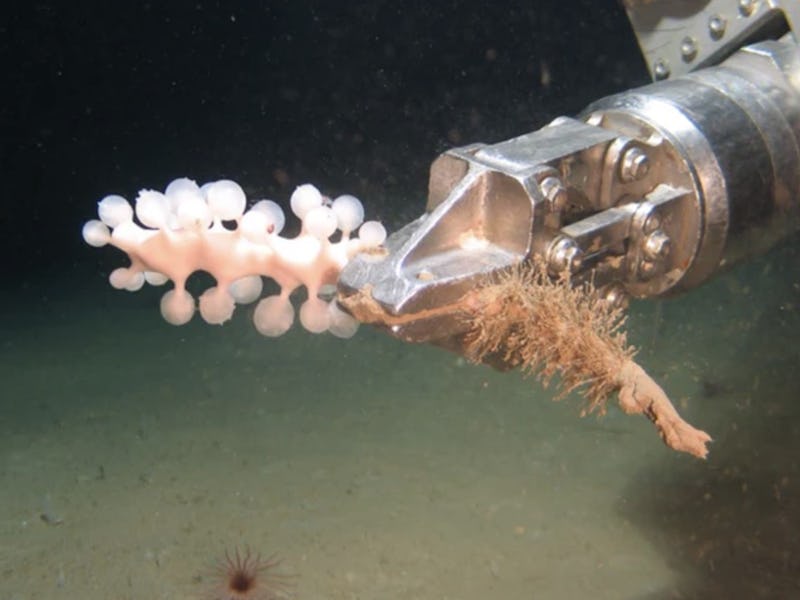Oil industry robots are being repurposed to save one of Earth's rarest wonders
Who knows secrets the oceans hold? Robots know.

The ocean remains Earth’s final frontier. For all of mankind’s scientific advancements, in 2018 the National Ocean Service reported that more than t80 percent of the world’s water remains unexplored. But scientists at the Australian Institute of Marine Science have a new idea to help close the gap: simply take robots that are already in circulation and re-rig them for scientific discovery.
They even have the perfect robots in mind, as discussed in their paper in the latest issue of the journal Frontiers in Medical Science, out April 15: remotely operated vehicles (ROVs) used by the oil and gas industry.
Dianne McLean, a fish ecologist and specialist in underwater video systems at AIMS, says in a press statement that using ROVs for research could be a “real win-win. With some low-cost engineering and operational tweaks, industry and science can use ROVs to fuel new scientific discoveries. For instance, we could better understand the influence of structures such as platforms and pipelines in marine ecosystems - to the mutual benefit of the resource company and the environment."
ROVs were invented in 1953 by the French camera designer Dimitri Rebikoff, who gained worldwide acclaim for his innovation in undersea technology and his partnership with explorer Jacques Costeu. While Rebikoff’s tethered robot, called the POODLE, was for scientific exploration, both government and industry quickly realized the many possibilities of undersea robots.
Current ROVs are untethered and advanced machines. They’re heavy-duty, like the Nexxus ROV from the Houston-based Oceaneering which has a standard depth rating of 10,000 feet below surface. They have a variety of power sources, like Oceaneering’s eNovus, which has an electric propulsion system that can take it up to 16,500 feet below the surface. Both machines come equipped with standard and high definition cameras.
The eNovus, hard at work at an industrial substation.
An ROV outfitted for marine samples.
They have an express purpose: to maintain the numerous industrial subsea structures. But Miles Parsons of AIMS, an acoustic expert and co-author of the study along with Dr. McLean, says they can be outfitted with extra sensors, cameras, acoustic transmitters and receivers, and sample collection devices.
That’s where the “win-win” comes in, Dr. McLean says: “from an industry point of view, these small additions to ROVs and their use for scientific surveys has the potential not only to improve environmental management but also to facilitate more informed engagement with external stakeholders such as regulators and the public."
Beyond retrofitting, the work that ROVs have already done while maintaining oil and gas substructures could prove valuable to science: “the images and video already collected by industry ROVs represent one of the most substantial visual datasets available from our oceans.
The global offshore energy industry holds a vast archive comprising millions of hours of underwater video and millions of still images, often collected from locations, habitats and depths rarely encountered by independent researchers,” the team writes in their paper.
There are a number of hold ups that stand in the way of ROV video being used in widespread science the team notes. These mainly deal with the fact that the machines are not in the water for scientific research in the first place: they don’t focus on fish, they have a limited field of a view more focused on machinery.
To compensate for these restrictions, the team devised a three-step scoring system that could analyze any ROV video to see if it has worthwhile material. If its criteria are met, the team anticipates that the standardization of high definition video could become a treasure trove.
“Where possible, '' the paper concludes, “industry should look ahead at future ROV schedules to best integrate science, ideally allocating time and budget to promote a successful mission.” The world’s oceans are by and large in dire straits.
Rising temperatures have threatened already vulnerable ecosystems like Australia’s Great Barrier Reef, which has seen new coral additions drop by a stunning 89 percent in recent years. ROVs could give scientists unprecedented access to information and research about the crisis under the sea. It’s up to the oil and gas industry to see if they’ll take advantage of the “win-win.”